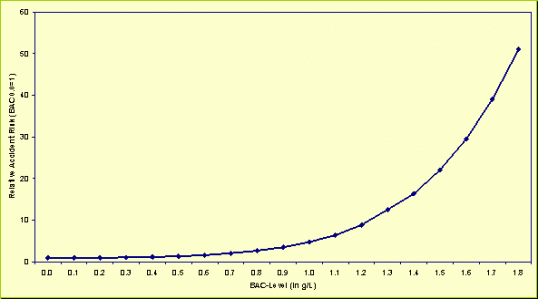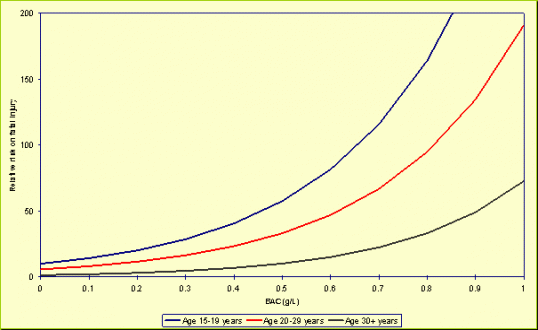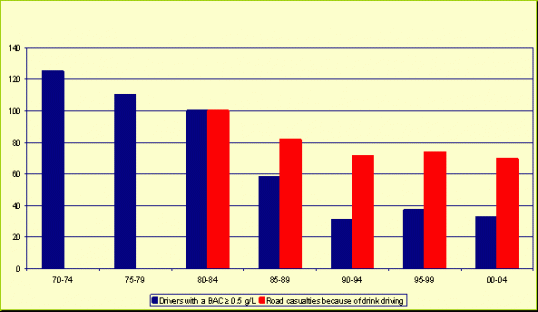Crashes and injuries
Crashes and injuries
Drink drivers are clearly over-represented in road traffic crashes. Alcohol related crashes are also severe. In Germany for example, the severity of drink-drive crashes (expressed as fatalities per 1,000 injury crashes) is nearly twice as high as that of crashes in general [34]. Unfortunately, almost none of the European countries systematically test all road users involved in crashes for alcohol. Therefore, alcohol related crashes are underreported in the official statistics of most European countries. In Germany, in 2003, 6.8% of all crashes with personal injury were alcohol related, according to the police records. On the basis of a sample in which the police were instructed to try to obtain breath samples from the driver responsible for causing the crash, [23] however estimate that about 12% of all crashes in Germany are attributable to alcohol. In Finland it is compulsory to test all road users involved in a fatal crash for alcohol. From the results of these tests it is concluded that in Finland 24% of all the fatally injured drivers had a BAC of 0.5 g/l alcohol or more. In Sweden more than 90% of all fatally injured drivers are tested. 28% of the drivers that had died in traffic in Sweden in 2004 had alcohol or other drugs in their blood. And in France from a sample of 7458 fatal crashes that happened between October 1st 2001 and September 30th 2003, 28.6% (95% confidence interval; 26.8% - 30.5%) appeared to be attributable to drivers that had alcohol in their blood [29].
It is also possible to estimate the number of drink drivers that have died in traffic crashes on the basis of the number of drivers that have ended up in hospital after a crash and are tested for alcohol. In a random sample in the Netherlands, 25% of severely injured drivers that had ended up in hospital, had alcohol in their blood [26]. Drink drivers not only kill themselves, but they also kill other road users (their passengers and/or the occupants of the vehicles and pedestrians they crash into). Based on the above mentioned research in the Netherlands, we estimate that around 25% of all the annual traffic fatalities are attributable to alcohol. Not only drink driving but also drink walking, drink riding and drink cycling cause fatalities. For instance Keigan & Tunbridge [22] estimate that in the United Kingdom 39% of the fatally injured adult pedestrians have a BAC-level that exceeds the legal limit for drivers (0.8 g/l) in the UK. In regard of all the percentages mentioned, the rather speculative estimation made by the European Commission that one quarter of the entire annual road fatalities in the European Union are due to alcohol, is probably not an exaggeration. If one assumes that the prevalence of drivers with a BAC of 0.5 g/l or more in is around 1 % of the total driver population in Europe (as is estimated for the Netherlands), than 1% of the drivers is responsible for around 25 % of the road fatalities in Europe.
Crash rate
The crash rate is calculated on the basis of epidemiological studies. To estimate the relative rate for drink drivers of getting involved in a crash, the distribution of BAC-levels in the entire driver population (measured in random roadside breath tests) is compared with the distribution of BAC-levels among drivers involved in crashes. These so-called case-control studies have been repeated over and over again and the results are very similar. A much-cited one is the Grand Rapids study by Borkenstein [8]. Borkenstein and colleagues were the first to carry out a profound case-control study. With the aid of modern techniques it is possible to control for even more confounding factors than in the Grand Rapids study. A methodologically sound modern case-control study is the study by Compton [9]. The results of this study are shown in Figure 7.
Figure 7: Relative rate for drink drivers to be involved in a crash as their BAC-level increases. The rate of a sober driver is set at 1. Source: Compton et al, 2002
The relationship between relative crash rate and BAC-level is exponential. From Figure 7 we may conclude that for instance the crash rate per kilometre driven for a driver with 0.8 g/l alcohol in his blood (still the legal limit in the United Kingdom, Ireland, Luxemburg, and Malta) is approximately 2.7 times higher than the rate for a sober driver. A difference between Figure 7 and the often cited but old 'Borkenstein curve' is, that the 'Borkenstein curve' had a small dip in relative crash rate for low BAC-levels between 0.0 g/l and 0.5 g/l. but the 'Compton curve' has not. Another difference is that the 'Compton curve' is steeper than the old 'Borkenstein curve'.
The curve for involvement in only fatal crashes is different from the curve for crash involvement in general. Up to BAC 1.0 g/l the rise in rate of crash involvement in general and the rise in rate of involvement in a fatal crash is more or less the same. Above this level the rise in rate for fatal crashes is much steeper than the rise in rate for all crashes. The relative crash rate for a driver with a BAC of 1.5 g/l is about 22, but his relative crash rate for fatal crashes with that amount of alcohol in his blood is about 200 [33]. Thus with increasing BACs not only the rate of a crash increases, but also the severity.
The increase in crash rate with increasing BACs is not the same for all age groups. In the United States, based on the crashes database (FARS) over the years 1987-1999, Preusser (2002) has developed Table 2:
|   | Relative Crash Rate | ||||||||
|---|---|---|---|---|---|---|---|---|---|
| Age | BAC 0.0 | BAC 0.1 | BAC 0.2-0.3 | BAC 0.4-0.5 | BAC 0.6-0.7 | BAC 0.8-0.9 | BAC 1.0-1.4 | BAC 1.5-1.9 | BAC 30.2 |
| 16-20 | 3.31 | 4.37 | 4.12 | 5.44 | 8.17 | 10.10 | 15.77 | 25.30 | 28.19 |
| 21-24 | 1.79 | 2.18 | 2.59 | 4.42 | 6.11 | 8.13 | 10.73 | 16.43 | 26.00 |
| 25-34 | 1.25 | 1.38 | 1.89 | 2.32 | 2.94 | 4.37 | 7.27 | 11.61 | 16.08 |
| 35-49 | 1.00 | 1.09 | 1.49 | 1.78 | 2.62 | 3.56 | 5.64 | 10.44 | 16.99 |
| 50-64 | 1.02 | 0.93 | 1.17 | 1.24 | 2.03 | 2.23 | 4.71 | 8.48 | 13.24 |
| 65+ | 2.04 | 1.97 | 2.49 | 2.50 | 2.50 | 3.55 | 4.83 | 7.48 | 9.48 |
Table 2: Relative crash rate by BAC and age group. Source: Preusser (2002)
From Table 2 we conclude that low doses of alcohol (lower than 0.5 g/l) have a far more devastating effect on young drivers (24 years of age and younger) than on older drivers (older than 24 years of age). Keall et al [21] did another study on this subject in New Zealand. Figure 8 is abstracted from this study.
Figure 8: Relative rate of fatal injury and BAC-level per age group. Source: Keall et al (2004)
Alcohol is not the only substance that impairs one's driving skills, other substances also do. In particular when illicit drugs are combined with alcohol, the effects are devastating. A case-control study in the Netherlands [26] revealed that the relative injury rate of BAC 0.5-0.8 g/l was 8.28 (95% confidence interval; 2.73-25.2) when only alcohol was consumed. For BAC 0.2- 0.8 g/l + illicit drugs it was 12.9 (95% confidence interval; 3.78-44.2). For BAC 3 0.8 g/l in combination with illicit drugs it even was 179 (95% confidence interval; 49.9-638). In another case-control study in France [24] it was found for at fault drivers in fatal crashes, that the relative rate of drivers that were intoxicated by both alcohol and cannabis (a relative rate of 14) was about the same as the product of relative rate of cannabis alone (a relative rate of 1.78) and alcohol alone (8.51).
Developments over time
Is the drink driving problem in Europe increasing or decreasing? To answer this question one needs to know the annual proportion of all fatalities and injuries in all EU-member states that are attributable to alcohol over a long period of time. Some EU-member states have quite reliable statistics about prevalence and the number of fatalities attributable to alcohol, but most EU-member states have not.
Swedler et al [34] have analysed a large number of studies on the drink driving problem in various countries over the past decades. They conclude that improved laws, stricter enforcement, and public awareness brought about by citizens' concern during the 1980s, have led to dramatic decreases in drinking and driving in the industrialized world. The decreases amounted to about 50% in Great Britain, 28% in the Netherlands, 28% in Canada, 32% in Australia, 39% in France, 37% in Germany, and 26% in the United States. Some of these decreases may be due in part to changes in lifestyle, demographic shifts, and economic conditions. In most countries the decreases reversed in the early 1990s and drinking and driving began to increase. By the middle of that decade the increases stabilized and the rate of drinking and driving began to decrease once more. These decreases were much less dramatic than those in the 1980s. At the end of the 1990s and early in the new century, the numbers vary. In some countries like France and Germany (Germany until 2002)) drinking and driving continued to decrease while in other countries (Canada, the Netherlands, Great Britain, and the United States), there was stagnation and in some cases there was a small or even a large increase, as was the case in Sweden. A major part of the increase in Sweden is believed to be related to a changing culture concerning alcohol consumption, in which everyday consumption in accordance with "continental" European habits is more common. The changing distribution between different types of beverages, in which the consumption of wine and beer is increasing and that of hard liquor is decreasing, supports this explanation. Another support is found in the fact that drinking is changing from being a weekend activity to becoming an everyday activity [28]. As an example a quantitative development for the Netherlands is presented in the box.
Drink driving developments over time in the Netherlands
Some of the estimates used to produce Figure 9 were rather speculative. Both the number of drivers with a BAC of 0.5 or more and the number of casualties (fatalities and severely injured road users) because of drink driving (the drink drivers themselves, their passengers and/or the occupants of the vehicles, and pedestrians they crash into) were indexed at 100 for the period 1980-1984.
Figure 9: Indexed development in the Netherlands of the proportion of drivers with a BAC ≥ 0.5 of the entire driver population and the proportion of road casualties (fatal and seriously injured) due to drunk driving of all casualties (80-84=100). Source: Wegman, F. & Aarts, L. (Ed.) (2005)
It was not possible to estimate the proportion of casualties due to drink driving for the periods 1970-1974 and 1975-1979. From Figure 9 we conclude that in the Netherlands both the proportion of all drivers that drive with a BAC over the legal limit (BAC 3 0.5 g/l) in the Netherlands, and the proportion of casualties due to drink driving, are declining. However drink driving seems to decrease faster than the number of crashes that involve drink drivers. At first sight this seems strange. A possible explanation is that drink driving has indeed decreased, but the number of drivers that drive while being intoxicated by both alcohol and illegal drugs has increased. As already mentioned, in combination with drugs, even small quantities of alcohol (quantities below the legal limit) can deteriorate one's driving skills enormously. Another explanation is that at least in the period 2000-2004 the number of drivers that drive with a BAC that is over the legal has indeed decreased, but the number of hard-core drink drivers (drivers with a BAC that is high above the legal limit) has not. This relatively small group of hard-core drink drivers is probably responsible for many casualties.



